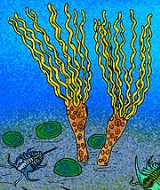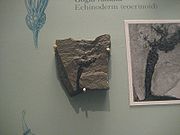
Gogia
Encyclopedia
Gogia is a primitive genus of the Class Eocrinoidea
, belonging to the early echinoderm
Subphylum Blastozoa
(Sprinkle 1973), dated from the Cambrian.
G. ojenai dates to the late Early Cambrian; other species come from various Middle Cambrian strata throughout North America, but the genus has yet to be described outside this continent.
The species of Gogia, like other eocrinoids, were not closely related to the true crinoid
s, instead, being more closely related to the blastoid
s.
 Gogia is distinguished from sea lilies, and most other blastoids, in that the plate-covered body was shaped like a vase, or a bowling pin (with the pin part stuck into the substrate), and that the five ambulacra
Gogia is distinguished from sea lilies, and most other blastoids, in that the plate-covered body was shaped like a vase, or a bowling pin (with the pin part stuck into the substrate), and that the five ambulacra
were split into pairs of coiled or straight, ribbon-like strands.
As a whole, the Eocrinoids are regarded as basal blastozoans very close to the ancestry of the entire subphylum.
Eocrinoidea
The Eocrinoidea are an extinct class of echinoderms that lived between the Early Cambrian and Late Silurian periods. They are the earliest known group of stalked, arm-bearing echinoderms, and were the most common echinoderms during the Cambrian....
, belonging to the early echinoderm
Echinoderm
Echinoderms are a phylum of marine animals. Echinoderms are found at every ocean depth, from the intertidal zone to the abyssal zone....
Subphylum Blastozoa
Blastozoa
Blastozoa is a subphylum of extinct animals belonging to Phylum Echinodermata. This subphylum is characterized by the presence of hydrospires.-External links:*...
(Sprinkle 1973), dated from the Cambrian.
G. ojenai dates to the late Early Cambrian; other species come from various Middle Cambrian strata throughout North America, but the genus has yet to be described outside this continent.
The species of Gogia, like other eocrinoids, were not closely related to the true crinoid
Crinoid
Crinoids are marine animals that make up the class Crinoidea of the echinoderms . Crinoidea comes from the Greek word krinon, "a lily", and eidos, "form". They live both in shallow water and in depths as great as 6,000 meters. Sea lilies refer to the crinoids which, in their adult form, are...
s, instead, being more closely related to the blastoid
Blastoid
Blastoids are an extinct type of stemmed echinoderm. Often called sea buds, blastoid fossils look like small hickory nuts. They originated, along with many other echinoderm classes, in the Ordovician period and reached their greatest diversity in the Mississippian subperiod of the Carboniferous...
s.

Ambulacrum
An ambulacrum is an architectural term for the atrium, courtyard, or parvise in front of a basilica that is surrounded by arcades or colonnades, often containing a fountain, and is surrounded by trees....
were split into pairs of coiled or straight, ribbon-like strands.
As a whole, the Eocrinoids are regarded as basal blastozoans very close to the ancestry of the entire subphylum.

